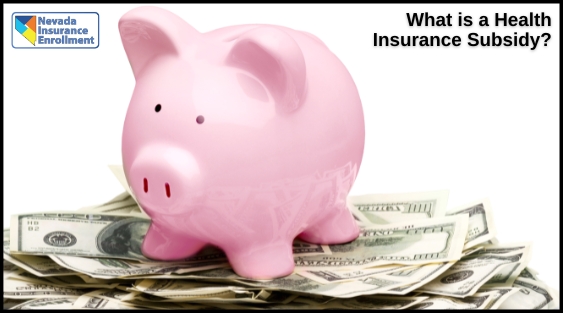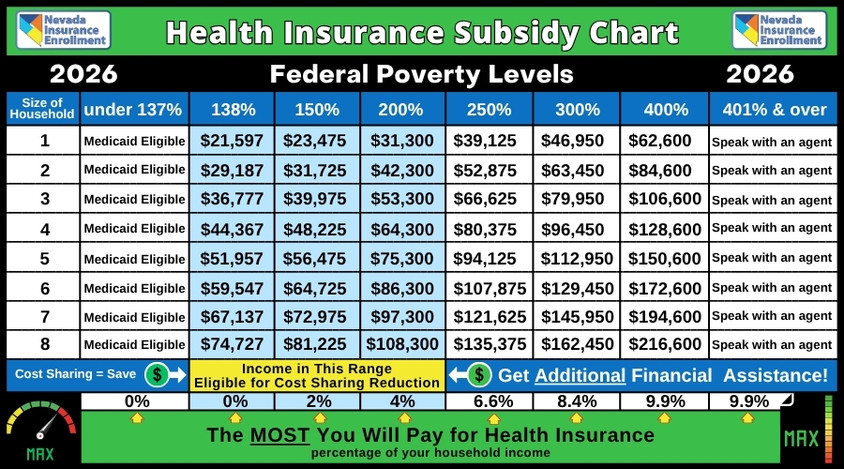aka: Advanced Premium Tax Credit
While having a comprehensive health insurance plan can ultimately save you thousands of dollars in hospital bills and other expenses, it can turn out to be a big monthly expense. On average (without a government subsidy) health insurance plans in Nevada cost between $160-$2,200 per month (or more) and for many this expense is a burden. Fortunately, financial assistance (in the form of a Government Subsidy) is available to those who qualify, making health insurance more affordable and quality coverage more accessible for everyone.

What Is a Health Insurance Subsidy?
A “Subsidy” is a special tax credit that you can take to help lower the cost of your monthly health insurance premiums. If you qualify for a Health Insurance Subsidy, it’s kind of like getting a gift card from the Government to help pay your health insurance premium. This subsidy is sent directly to the insurance company, which pays a portion of your premium, and you will be responsible for paying the remaining balance.
The factors that affect the premium you pay (after you’ve had your subsidy calculated and applied), would be your household income, and the number of family members on your tax return.
Qualifying for a Government Subsidy (Financial Assistance)
When you sign up for health insurance coverage at Nevada Health Link, you provide an estimate for how much income you expect to bring in for that year. Based on that amount, you may qualify for a premium tax credit. Instead of receiving that tax credit on your federal tax return, you can use any amount (up to 100%) of the credit in advance to lower your monthly health insurance premium.

How Premium Tax Credits Can Save You Money
Premium tax credits reduce how much money you must pay monthly for your health insurance plan. If you qualify for this credit, you have two options for using it.
1. Your first option is to have the federal government send the credit directly to your health insurance carrier each month, then you just pay the remaining premium.
2. Your second option is to get the tax credit when you file your federal income taxes. With this option, you pay the full premium each month and get the credit in a lump sum on your tax return.
Do You Qualify for a Health Insurance Subsidy?
• The LESS money you make, the MORE financial help you will get.
• The MORE money you make, the LESS financial assistance you get.
The only way to get a “Subsidy“ is to get a health insurance plan through Nevada Health Link (we will walk you through this). You can call us for help with both Subsidized and Unsubsidized health insurance plans.
If your income is below 138%, you may be eligible for Medicaid. You could apply for Medicaid through the DWSS – Department of Social Services.
Recent Posts

Why Have PPO Plans Vanished from Nevada’s Individual Market?
The PPO plan decline reflects a Nevada health plan shift, with Nevada Health Link offering HMO/EPO plans due to ACA rules and record 2025 enrollment. These plans limit provider choices but ensure affordable coverage. Learn why PPO plan reduction occurred and how to choose coverage.

Health Insurance Benefits for American Indians
Health insurance for American Indians offers zero cost-sharing, monthly enrollment, and IHS access via Nevada Health Link. The ACA ensures affordable Nevada tribal health coverage with premium tax credits and Medicaid/CHIP options. Learn how to navigate tribal health insurance benefits.

What is a Summary of Benefits and Why Should I Read It?
A summary of benefits (SBC) is a 4-page document explaining a health insurance plan’s coverage, costs, and examples. It helps compare plans, understand costs like premiums and deductibles, and assess coverage for services like doctor visits or preventive care. Available through Nevada Health Link, the SBC is standardized for easy comparison but does not include provider networks or full exclusions. Learn how to use the SBC to choose a plan that fits your needs.
Use the Subsidy Chart to see if you qualify

Be Careful Here
You do not want to understate your income or you could end up owing money to the IRS.
For example, if your premiums are $1,000/month and you get an Advanced Premium Tax Credit of $800/month only paying $200/month for your health insurance. When you do your taxes and file your tax return each year, the Government will check your income. If you were only supposed to receive an Advanced Tax Credit of $700/month instead of $800/month, you’ll owe the IRS an extra $100/month x 12 months which would equal $1,200 that you would owe the IRS.
The Advanced Premium Tax Credit is an “estimation” of your pre-tax credit, so if you’ve received too much “credit,” you’ll end up paying it all back, or a portion of it back. Your percentage of Federal Poverty Level determines this.
Call for FREE Help
(702) 898-0554
2026 Health Insurance Subsidy Chart
by household size and income
The chart below lists the income numbers the IRS will use for subsidy eligibility.

* The annual subsidy amounts change in January of each year
* NOTE: You can buy a plan outside of the “Marketplace” that doesn’t have a subsidy
Health Insurance Quotes
2). Online Quote
3). In Person
4260 W. Craig Road #150-A
N. Las Vegas, NV 89032
The IRS Will Verify Your Income
Your income will be checked with the IRS records and/or a Federal Database, so if you claim a certain income, the Public “Exchange” will check your past years income tax records before you get approved for a subsidy. You’ll really want to make sure the income you state is very close to what it will actually be.
Individuals and families will state their income based on their “MAGI” (Modified Adjusted Gross Income). That information will then be verified through several Government entities including the IRS. If the stated income on the application is more than 10% lower than what the IRS shows, the State will require the individual to prove their income within 90 days, but you’ll still get enrolled. Your financial information is run through a Data Services Hub (a tool the government is using to verify applicant information and income for the “Advanced Premium Tax Credits”) to see if you qualify for a subsidy.
Search This Website
Most Popular Pages
By page visits (this month)
#1) Health Insurance Subsidy Chart
#2) Health Insurance
#3) Health Insurance WITH a Subsidy
#4) Insurance Blog
#5) Request a Quote
Stating Your Income For a Health Insurance Subsidy
Be careful not to get TOO MUCH subsidy. At the end of the year, the IRS will review how much subsidy you received, and what you should have received. If you ended up getting too much subsidy, you’ll have to pay it back, and if you didn’t get enough subsidy, you’ll get it back on your tax return.
For example, if your premiums are $1,000/month and you get an Advanced Premium Tax Credit of $800/month and you only have to pay $200/month. When you do your taxes and file your tax return that year, the Government will check your income. If you were only supposed to receive an Advanced Tax Credit of $700/month instead of $800/month ($100 difference), you’ll owe the IRS an extra $1,200. This is only an estimate, and the actual amount will depend on your Federal Poverty Level.
Throughout the year, if your income goes up or down, or you have changes to your family, you need to notify your agent of these changes.
Changes That Help Higher Income Individuals and Families
More Nevadan’s may now be eligible for health insurance tax credits. For existing members, you may be entitled to a higher tax credit. If you previously were denied assistance, you may now be eligible to receive a Government subsidy to help pay for your health insurance premiums. Before these changes, if your income was over $51,040 for a single person in tax year 2021, or $104,800 for a family of 4, you were not eligible for a tax subsidy because your income was too high.
Now there is no income limit to receive these subsidies. The subsidy amount gradually slopes off to where your monthly premium is no more than 8.5% of your household income (modified adjusted gross – for most people, their “Adjusted Gross Income”). So, for many Nevadan’s, they’ll now be eligible for tax credits! This is AMAZING news and will make a HUGE difference in so many people’s lives.
For example: If you were a 60 and 61 year old married couple, and your income was projected to be over $68,960 in 2021 you would not have qualified for a tax credit. Now, since the changes, that same couple making $80K per year would qualify for $1007 per month in assistance!
Eligibility Requirements for the Advanced Premium Tax Credit
The American Rescue Plan Act ensures that all households including those who earn more than 400% of the federal poverty level, can receive a premium tax credit if the cost of the “benchmark plan” (2nd lowest cost Silver plan in Nevada) would otherwise amount to more than 8.5% of the household income. Also, you don’t qualify for a subsidy if you have Medicaid, have insurance offered through a parent, spouse, VA, CHIP, employer, or others. This may change in the future. In addition, you must file taxes and reconcile your taxes each year.
Let Nevada Insurance Enrollment Guide You
Enrolling into a health insurance plan can be confusing, with so many steps in the process, it’s easy to get lost in the chaos. Let one of our experienced local health insurance agents guide you through enrollment. Having an agent help you doesn’t cost you anything, the service we offer is FREE.
Top 5 Most Popular
By page visits (this month)
#1) Health Insurance Subsidy Chart
#2) Health Insurance
#3) Health Insurance WITH a Subsidy
#4) Insurance Blog Posts
#5) Request a Quote
Recent Posts
Health Insurance Benefits for American Indians
Health insurance for American Indians offers zero cost-sharing, monthly enrollment, and IHS access via Nevada Health Link. The ACA ensures affordable Nevada tribal health coverage with premium tax credits and Medicaid/CHIP options. Learn how to navigate tribal health insurance benefits.
What is a Summary of Benefits and Why Should I Read It?
A summary of benefits (SBC) is a 4-page document explaining a health insurance plan’s coverage, costs, and examples. It helps compare plans, understand costs like premiums and deductibles, and assess coverage for services like doctor visits or preventive care. Available through Nevada Health Link, the SBC is standardized for easy comparison but does not include provider networks or full exclusions. Learn how to use the SBC to choose a plan that fits your needs.
Nevada Insurance Requirements for Vehicle Registration
Confused about insurance requirements for vehicle registration in Nevada? Learn why auto insurance is mandatory, with minimum liability coverage of 25/50/20. Understand how to provide proof, navigate the registration process, and avoid costly lapses. From required documents to penalties, this guide covers it all. Discover optional coverages and cost-saving tips to stay protected.
What Is a Health Insurance Carrier?
A health insurance carrier provides plans to cover medical expenses, like doctor visits and prescription medications. Understanding your insurer’s network, plan types (HMO, PPO), and costs (premiums, deductibles) is key to choosing coverage. In Nevada, carriers collaborate with Nevada Health Link to offer ACA-compliant plans, ensuring access to preventive care and essential benefits. Learn how to select a dependable health insurance company and manage costs effectively.
